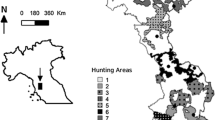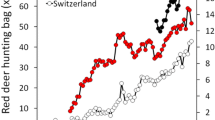Abstract
The aim of this study was to provide information on the reproductive biology of brocket deer. Hence, we analyzed female reproductive tracts collected by rural hunters from 1991 to 1998 in the Tamshiyacu-Tahuayo Communal Reserve, northeastern Peruvian Amazon. We characterized the basic reproductive biology of brocket deer, analyzed whether the distributions of conceptions and births are aseasonal, and compared their reproductive productivity in two different areas subject to heavy and slight hunting pressures, respectively. We found that: (1) red and gray brocket deer did not differ in ovulation, fertilization, and pregnancy rates; (2) average number of fetuses per birth was 1.2 for red brocket deer and one for gray brocket deer; (3) sex of fetuses suggests a male biased sex ratio for both species; (4) neither species shows reproductive seasonality; and (5) gross productivity does not differ between heavily and slightly hunted areas. Our results indicate that brocket deer exhibit reproductive characteristics similar to their conspecifics in other parts of their native distribution range.



Similar content being viewed by others
References
Armstrong RA (1950) Fetal development of the northern white-tailed deer. Am Midl Nat 43:650–666
Begazo A (1999) Hunting of birds in the Peruvian Amazon. Ph.D. Thesis, University of Florida, Gainesville
Bisbal FJ (1994) Biología poblacional del venado matacan (Mazama spp) (Artiodactyla: Cervidae) en Venezuela. Rev Biol Trop 42:305–313
Bodmer RE (1989) Frugivory in Amazonian Artiodactyla: evidence for the evolution of ruminant stomachs. J Zool 222:121–128
Bodmer RE (1994) Managing wildlife with local communities: the case of the Reserva Comunal Tamshiyacu-Tahuayo. In D. Western, M. Wright and S. Strum, (eds.) Natural Connections: Perspectives on Community Based Management. Island Press, Washington D.C., pp. 113–134
Bodmer RE (1995) Managing Amazonian wildlife: biological correlates of game choice by detribalized hunters. Ecol Appli 5:872–877
Bodmer RE (1997) Ecologia e conservacao dos veados mateiro e catingueiro na amazonia. In: Duarte JM (ed) Biologia e conservacao de cervideos sul-americanos: Blastocerus, Ozotoceros e Mazama. FUNEP, Jaboticabal, pp 70–77
Bodmer RE, Aquino P, Puertas P, Reyes CJ, Fang TG, Gottdenker NL (1997) Manejo y uso sustentable de peccaries en la Amazonia Peruana. Occ. Pap. IUCN Sps. Surv. Comm. 18. IUCN-Sur, Quito, Ecuador ecretaria CITES, Ginebra, pp. iv+102
Branan WV, Marchinton RL (1987) Reproductive ecology of white-tailed deer and red brocket deer in Suriname. In: Wemmer C (ed) Biology and management of the Cervidae. Smithsonian Institution, Washington, DC, pp 344–351
Brokx PA (1972) Ovarian composition and aspects of the reproductive physiology of Venezuelan white-tailed deer (Odocoileus virginianus gymnotis). J Mammal 53:760–772
Bronson FH (1989) Mammalian reproductive biology. Univ of Chicago Press, Chicago, IL
Caughley G (1977) Analysis of vertebrate populations. Wiley, New York
Frädrich H (1987) The husbandry of tropical and temperate cervids in the West Berlin zoo. In: Wemmer C (ed) Biology and management of the Cervidae. Smithsonian Institution, Washington, DC, pp 422–428
Gardner AL (1971) Postpartum estrus in a red brocket deer, Mazama americana, from Peru. J Mammal 52:623–624
Gottdenker N, Bodmer RE (1998) Reproduction and productivity of white-lipped and collared peccaries in the Peruvian Amazon. J Zool 245:423–430
Hellgren EC, Synatzke DR, Oldenburg PW, Guthery FS (1995) Demography of a collared peccary population in South Texas. J Wildl Manage 59:153–163
Hudson P, Brownman LG (1959) Embryonic and fetal development of the mule deer. J Wildl Manage 23:295–304
Hurtado-Gonzales JL, Bodmer RE (2004) Assessing the sustainability of brocket deer hunting in the Tamshiyacu-Tahuayo Communal Reserve, northeastern Peru. Biol Conserv 116:1–7
Julia JP, Richards E (1997) Estado de conservación de las corzuelas (Mazama spp.) en el noreste Argentino. In: Resúmenes presentados en el III Congreso Internacional sobre Manejo de Fauna Silvestre en la Amazonia. Santa Cruz, Bolivia. 3–7 (de Diciembre de 1997)
Leader-Williams N (1988) Reindeer on South Georgia: the ecology of an introduced population. Cambridge Univ Press, Cambridge
Macnamara M, Eldridge WD (1987) Behavior and reproduction in captive pudu (Pudu pudu) and red brocket deer (Mazama americana), a descriptive and comparative analysis. In: Wemmer C (ed) Biology and management of the Cervidae. Smithsonian Institution, Washington, DC, pp 371–387
Muller E, Duarte JMB (1992) Utilizacao da citologia vaginal efiolativa para monitoracao do ciclo estral em veado-catingueiro. In: XVI Congresso da sociedade de Zoologicos do Brasil Anais
Redford KH, Eisenberg JF (1992) Mammals of the Neotropics: The southern cone, vol 2. Chile, Argentina, Uruguay, Paraguay. Univ of Chicago Press, Chicago, IL
Sadleir RMFS (1987) Reproduction of female cervids. In: Wemmer C (ed) Biology and management of the Cervidae. Smithsonian Institution, Washington, DC, pp 123–144
SENAMHI (1996) Servicio Nacional de Meteorologia e Hidrologia del Peru. Reporte Climatologico 1986–1995. Lima, Peru
Severinghaus CW (1949) Tooth development and wear as a criterion of age in white-tailed deer. J Wildl Manage 13:195–216
Stallings JR (1986) Notes on the reproductive biology of the grey brocket deer (Mazama gouazoubira) in Paraguay. J Mammal 67:175–176
Townsend WR (1995) The sustainability of subsistence hunting by the Sirionó Indians of Bolivia, Ph.D. Thesis, Univ of Florida Press, Gainesville, FL
Zar JH (1998) Biostatistical Analysis, 4th edn. Prentice Hall
Acknowledgements
We sincerely thank all the people from the Tamshiyacu-Tahuayo Communal Reserve who participated actively in data collection, which shows that communal participation is an important step in the development of wildlife management. We also extend our thanks to P. Puertas, E. Pezo, C. Lopez, M. Overjluiz and L.C. Watson for their kind assistance during research and publication process.
Author information
Authors and Affiliations
Corresponding author
Rights and permissions
About this article
Cite this article
Hurtado-Gonzales, J.L., Bodmer, R.E. Reproductive biology of female Amazonian brocket deer in northeastern Peru. Eur J Wildl Res 52, 171–177 (2006). https://doi.org/10.1007/s10344-006-0034-6
Received:
Accepted:
Published:
Issue Date:
DOI: https://doi.org/10.1007/s10344-006-0034-6




